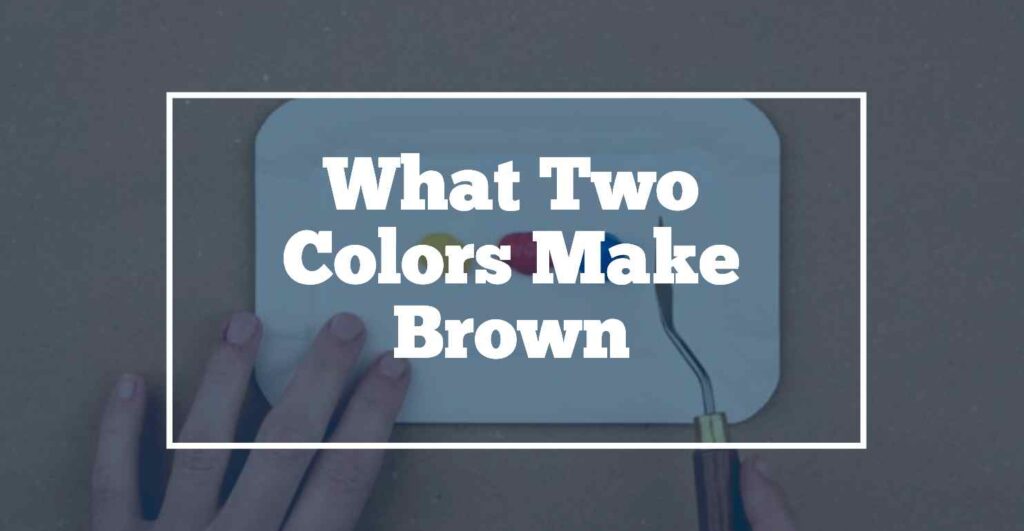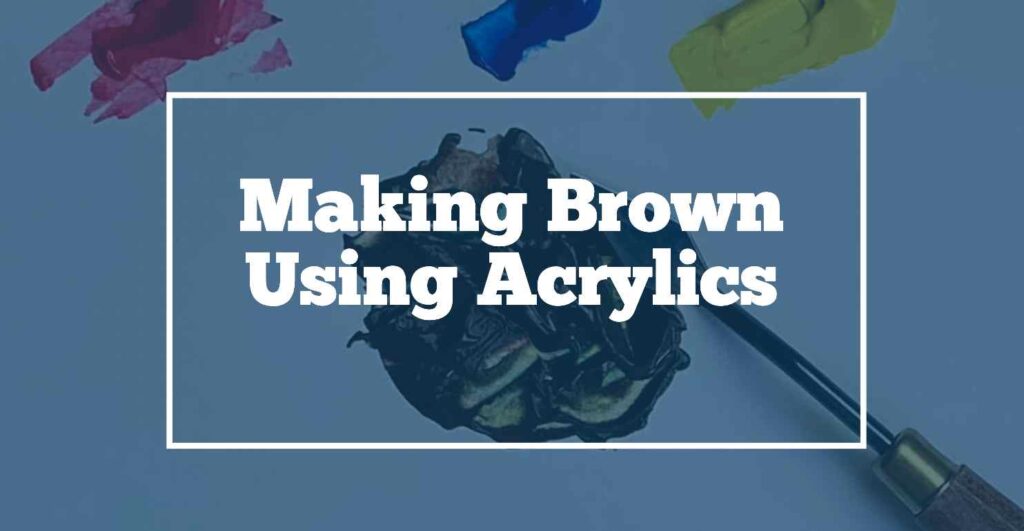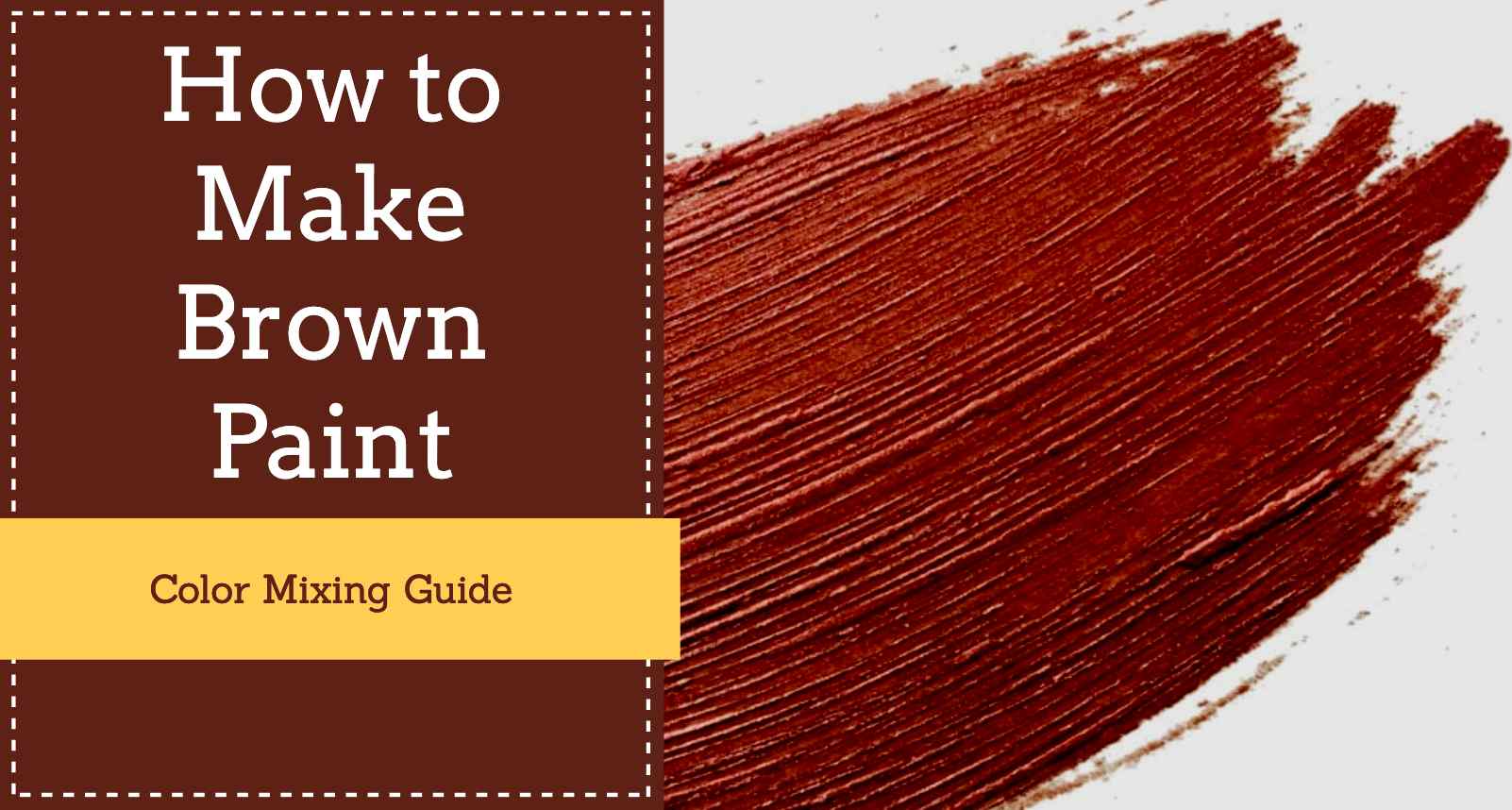Brown is one of the versatile colors when it comes to painting. It’s like the hidden star that makes a painting look complete and real. But making the right brown can be a bit headache. Some people think it’s just mixing a few colors, but there’s a bit more to it. No matter if you’re new to painting or have been doing it for a while, and no matter if you’re using watercolors, acrylics, or oil paints, this guide is for you. We’re going to talk about how to make brown in an easy way. By the end of this article, you’ll know the steps and tips to get the perfect shade of brown for your painting.
Also Read: How To Make Tan Paint
What Two Colors Make Brown

Alright, let’s delve into the basics of color mixing. Making brown might sound like a mystery, but it’s actually pretty straightforward. Ever wonder which two primary colors can give you brown? It’s blue and orange! Yep, you read that right. When you mix blue and orange together, you get brown. But here’s the thing, since orange is made by combining red and yellow, essentially, you’re mixing blue, red, and yellow to get brown. The key is to play around with the amounts. More blue will give you a deeper, darker brown. More orange (or red and yellow) will give you a warmer, lighter brown. It’s like a fun art experiment. Try it out with your paints and see what kind of brown you end up with.
Making Brown Using Acrylics: A Step-by-Step Guide

- Get Ready Your Materials: Before we begin, make sure you have your acrylic paints, a palette (or any flat surface) to mix on, a palette knife or a mixing brush, and some water for cleaning.
- Start with the Basics: Place a small amount of blue paint on one end of your palette. Next to it, place an equal amount of orange. If you don’t have an orange on hand, don’t worry! Just mix equal parts of red and yellow to make your own orange. You can also check our comprehensive guide on making orange.
- Mix Blue and Orange Together: Using your palette knife or brush, slowly drag some of the blue into the orange (or the mix of red and yellow). As you mix them, you’ll start to see the brown appear. Remember, mixing gradually is the key.
- Adjust the Shade: If you want a darker brown, add a touch more blue. For a warmer, lighter brown, add some more red and yellow. The fun part about mixing is that you can adjust it until it’s just right for you.
- For Richness and Depth: A little trick some artists use is to add a tiny bit of purple or green. This can make the brown richer and deeper, but be careful – a little goes a long way!
- Check Consistency: Acrylics can be thinned with a bit of water if your mix is too thick. Add a few drops at a time and mix until you get the consistency you want.
- Test It Out: Before using it in your main painting, test the brown on a scrap piece of paper or canvas. This lets you see the true shade when it’s dry and gives you a chance to make any last-minute adjustments.
- Store If Needed: If you’ve mixed a good amount and want to save some for later, you can store it in an airtight container to keep it from drying out.
- Clean Up: Remember to clean your brushes and palette right after you’re done. Acrylics can be stubborn once they dry, but with a bit of water and soap, they’ll come right off.
And there you have it! Step by step, you now know how to create a beautiful shade of brown using acrylic paints.
Making Brown Using Oil Paints: A Step-by-Step Guide
- Prepare Your Workspace: With oil paints, it’s crucial to have a clean and tidy workspace. Lay down some newspaper or a drop cloth to protect your surface. Grab your oil paints, a mixing palette, a palette knife, some linseed oil or paint medium (if needed), and paper towels or rags for cleaning.
- Lay Out the Basics: Place a small amount of blue paint on your palette. Beside it, squeeze out an equal amount of orange. If you don’t have pre-made orange, you can create it by combining equal parts of red and yellow.
- Begin Mixing: Using your palette knife, gently pull some of the blue into the orange (or red and yellow combination). As the colors blend, a shade of brown will emerge. Take your time, mixing slowly ensures an even color.
- Tweak the Shade: For a deeper, darker brown, add more blue. To lighten it or make it warmer, introduce more red and yellow. The beauty of oil paints is the richness they bring, so small adjustments can make a big difference.
- Depth and Dimension: Some artists like to introduce a touch of purple or green for added depth. It deepens the hue of the brown. But remember, a little amount will do too much, and it might overpower your mix.
- Check the Consistency: If your paint feels too thick or sticky, you can thin it with a bit of linseed oil or a suitable oil paint medium. Mix it in gradually until you get the desired consistency.
- Sample First: Before committing to your artwork, test your brown on a corner or a scrap piece. This ensures you’re happy with the color, especially once it starts to dry.
- Storage Tips: Oil paints dry slower than acrylics. If you’ve made extra, you can transfer it to a small, airtight container or wrap it in some plastic wrap for short-term use.
- Clean Up Time: Cleaning oil paints requires a bit more effort than water-based paints. Use a paint thinner or turpentine to clean your brushes and palette. Make sure to rinse thoroughly and reshape your brushes to maintain their form.
And that’s how you craft the perfect shade of brown using oil paints! Dive in, experiment, and most importantly, enjoy the process.
Making Brown Using Watercolors: A Step-by-Step Guide
- Set Up Your Space: Watercolors can be both delicate and messy. Ensure you have watercolor paper, brushes of various sizes, a bowl of water for rinsing, your watercolor set, and some paper towels handy.
- Begin with the Essentials: Wet your brush and pick up some blue paint. Lay a wash of blue on one section of your palette or a mixing tray. Beside it, apply a wash of orange. Remember, if you don’t have orange readily available, you can create it by mixing red and yellow.
- Start Combining: With a clean, wet brush, pull some of the blue into the orange (or your red and yellow mixture). As they mingle, you’ll begin to see the brown taking form. Watercolors are transparent, so blending them produces softer, more subtle results compared to other mediums.
- Adjust the Hue: If you’re after a deeper brown, incorporate more blue. For a lighter, more earthy brown, add a bit more of the red and yellow combination.
- Enhance Depth: A touch of purple or green can add depth to your brown. You can check this guide for making your own purple paint. However, with watercolors, always remember that less is more. Since the colors are transparent, layers and color intensity build gradually.
- Check the Intensity: Watercolors allow you to control the depth of the color by the amount of water you use. For a lighter shade, dilute your brown with more water. For more intense color, use less water and more pigment.
- Practice First: Before adding the color to your main piece, try it on a scrap or corner of your watercolor paper. This way, you can see how it dries and if any adjustments are needed.
- Clean Up: Simply rinse your brushes in water. Make sure to reshape them while they’re wet to ensure they retain their form. Clean your palette or mixing tray with water as well.
With these steps, you’re all set to create beautiful shades of brown using watercolors. Remember, watercolor is about layering and patience, so take your time and enjoy the journey.
Also Read: How To Make Peach Paint
FAQs
1. Can I mix different brands of acrylics, oil paints, or watercolors together to achieve the desired brown shade?
Yes, you can mix different brands together. However, ensure the types of paint (acrylic, oil, or watercolor) are the same when mixing.
2. How can I make my brown shade lighter without making it too pastel or washed out?
For a lighter shade, add a touch of white or yellow. Add gradually to ensure the color doesn’t become overly pale or pastel.
3. My brown turned out too dark. How can I lighten it without changing the color too much?
For acrylics and oils, add a small amount of white or a lighter shade of brown. For watercolors, you can dilute with more water or overlay with a light wash of yellow.
4. How long will my mixed brown paint last before it dries out?
Acrylics dry quickly, often within hours. Oil paints can take days or even weeks to dry fully. Watercolors, when in pans or tubes, can be reactivated with water and used for years.
5. Can I use additives or mediums to extend the drying time of my brown paint?
Yes. For acrylics, you can use retarders. For oil paints, certain mediums like stand oil or linseed oil can extend drying time.
6. Why does my brown paint look different when dried compared to when it was wet?
Paints, especially watercolors, can appear different once dried. Acrylics may darken slightly, and watercolors might look lighter due to their transparency.
7. How can I create a more textured brown shade in my artwork?
For acrylics and oils, you can mix in modeling paste or gel mediums to add texture. With watercolors, paper texture plays a significant role, so choosing rough or cold-pressed paper can achieve this.
8. How do I prevent my brown watercolor from looking muddy or overworked?
Work in layers, allowing each to dry before adding another. Also, avoid overmixing or excessively brushing back and forth.
9. Are there pre-mixed brown shades available that I can use directly without mixing?
Yes, many brands offer pre-mixed brown shades like burnt sienna, raw umber, and burnt umber. These can be used directly or adjusted with other colors.
10. If I run out of blue, can I still make brown using other colors?
Absolutely! Mixing complementary colors, like red and green or purple and yellow, can also produce brown shades.
Conclusion:
The art of mixing colors, especially to achieve the perfect brown, is all about understanding and experimentation. Whether you’re wielding acrylics, dabbling in the rich world of oil paints, or feeling the fluid rhythm of watercolors, the journey to your desired shade of brown is an exploration of nuances. Each type of paint brings its own charm, characteristics, and challenges. But as with many artistic processes, patience and practice make perfect. Armed with the basics of color theory and a willingness to experiment, anyone can master the creation of this versatile color. And remember, sometimes it’s the unexpected results that lead to the most beautiful masterpieces. So, embrace the process, enjoy every brushstroke, and let the world of brown unfold before you.

